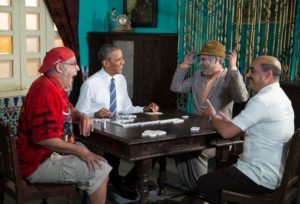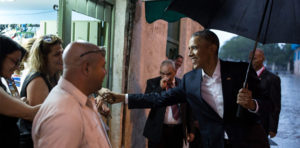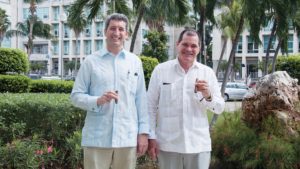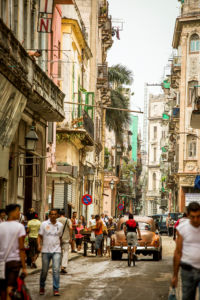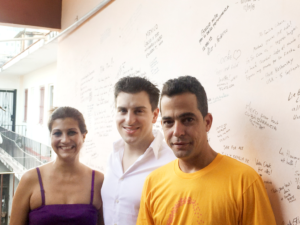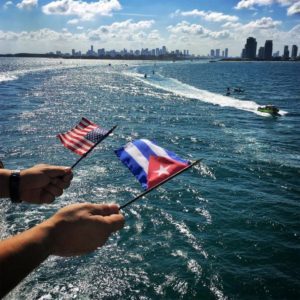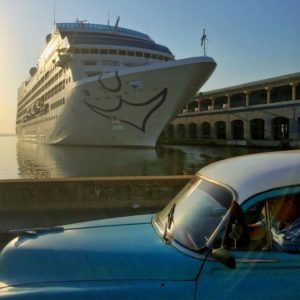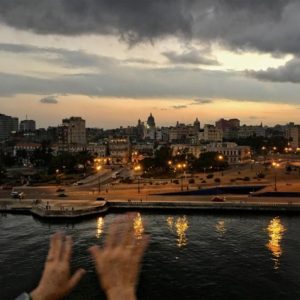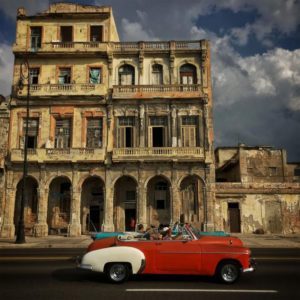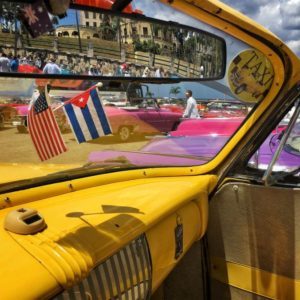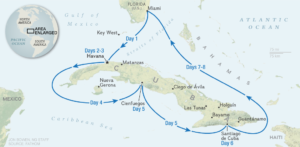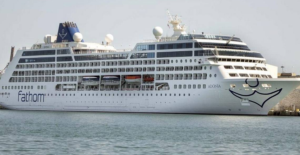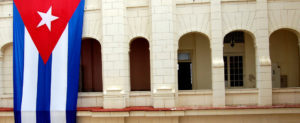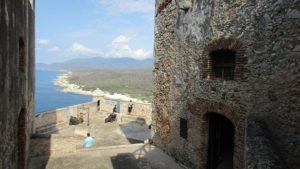Gerard Dion's Blog, page 20
May 24, 2016
How the Real Obama Met the Real Pánfilo
Dion Publishing Proudly presents the following article.
How the Real Obama Met the Real Pánfilo
This is something many Cubans never expected to see
By Ben Rhodes Deputy National Security Advisor for Strategic Communications & Speechwriting.
Terry Szuplat, Senior Director of Speechwriting at the National Security Council
So how’d this happen?
For those of us at the White House, it always starts with a question:
How can the President best connect with the people he’s trying to reach?
That’s what President Obama and those of us on his staff ask whenever he travels around the world. Yes, he’ll meet with presidents and prime ministers. But one of the things he values most during his foreign travels is the chance to reach and forge a connection with ordinary people — the people whose support we need for partnerships between our countries.
He holds town halls where he hears directly from students, entrepreneurs, and human rights advocates and answers their questions—something unthinkable in some countries where leaders rarely, if ever, subject themselves to scrutiny by their citizens. He sits down with journalists and social entrepreneurs who are working to improve their communities, from the grassroots up.
As we prepared for the President’s historic trip to Cuba, this question—how to reach the Cuban people — took on added significance. Government-owned television and newspapers would surely have extensive coverage of the President’s meetings with President Castro, his discussion with Cuban entrepreneurs, and his attendance at the big baseball game. And the government had indicated that it would broadcast live President Obama’s speech to the Cuban people, which it did.
Still, the President’s communication team — led by Deputy National Security Advisor Ben Rhodes — was looking for opportunities where the President could reach out to the Cuban people in a less formal, more familiar setting.
Enter Pánfilo.
In Havana, Ambassador Jeff DeLaurentis pitched an idea: President Obama could team up with Pánfilo, an elderly Cuban character played by Luis Silva, one of Cuba’s most popular comedians. His weekly show on state television is approved by the Cuban government, but Pánfilo is still given more license than others to point out the daily struggles of ordinary Cubans and even poke fun at the government. In one running skit, Pánfilo tries to call President Obama on the phone—but he never gets through.
This time, we decided Pánfilo would call and actually get through to the President.
Easier said than done. Luis speaks very little English, and I don’t speak Spanish. So Luis hand-carried his script to the U.S. embassy in Havana, where it was translated into English and emailed to us at the White House. We offered our edits, emailed it back to our team in Havana, who translated it back into Spanish for Luis. A few rounds of that, and a few days later, we had our script.
President Obama taped his portion of the video in the Oval Office two days before he departed for Havana. In it, Pánfilo can’t believe it’s the President — “the real Obama?” he asks. President Obama replies — “the real Pánfilo?”
Watch it here:
The U.S. Embassy and Luis posted the video online the next day, and within hours it was spreading across Cuba. The President hadn’t even landed in Havana and his outreach to the Cuban people had already begun.
It’s been estimated that the video has been viewed more than 2.3 million times online so far, by folks here and in Cuba. Some called it Cuba’s first viral video ever. That’s even more remarkable considering that very few Cubans — by some estimates, only five percent — have access to the Internet. Once it was broadcast on state television, the video reached virtually every Cuban household.
Cubans had never seen anything like it: a president of a country talking and joking with a Cuban, a comedian, the same way the rest of us kid around with our own family and friends. Over and over, those of us who joined President Obama in Cuba were told by Cubans we met that they had seen the President and Pánfilo, too. And they said it with pride.
“It made a big impression on me,” one Havana resident told an American reporter. It showed that President Obama seems to be “open-minded, reasonable and someone capable of putting himself in other’s shoes.”
But that video of their phone call was only the first act. The second came in Havana. In between public events, the President kept his promise and stopped by to see Pánfilo.
In the corner of warehouse in a cervecería in Old Havana, where the President would deliver a public speech moments later, Luis and his team had built a replica of his set. Around a table in his house, Pánfilo and his friends Chequera and Facundo are playing dominoes. When Pánfilo wishes there was a fourth pl This full skit has aired on Cuban television. Most Cubans, perhaps millions, have seen it through the weekly digital paquete — thumb drives that Cubans pass among themselves so they can see the latest entertainment and news. In coming to visit Pánfilo, many Cubans feel as though President Obama came to visit their home, too.
These are the moments — often more than any policy pronouncements — that truly allow the President to create a genuine, often emotional, bond with people around the world. It’s public diplomacy at its best—building the mutual respect and understanding we need with other countries, especially their citizens, to solve global challenges together.
And, as Pánfilo showed, sometimes it’s pretty fun, too.
Terry Szuplat is Special Assistant to the President and Senior Director for Speechwriting at the National Security Council.
ayer, in walks President Obama, who says, “I told you I’d see you in Havana.”
This full skit has aired on Cuban television. Most Cubans, perhaps millions, have seen it through the weekly digital paquete — thumb drives that Cubans pass among themselves so they can see the latest entertainment and news. In coming to visit Pánfilo, many Cubans feel as though President Obama came to visit their home, too.
These are the moments — often more than any policy pronouncements — that truly allow the President to create a genuine, often emotional, bond with people around the world. It’s public diplomacy at its best—building the mutual respect and understanding we need with other countries, especially their citizens, to solve global challenges together.
And, as Pánfilo showed, sometimes it’s pretty fun, too.
Terry Szuplat is Special Assistant to the President and Senior Director for Speechwriting at the National Security Council.
Article shared through social media
CUBA UNCHAINED BY Gerard Dion
A Failed Approach
Dion Publishing Proudly presents the following article.
A Failed Approach
By Ben Rhodes Deputy National Security Advisor for Strategic Communications & Speechwriting.
Decades of U.S. isolation of Cuba have failed to accomplish our objective of empowering Cubans to build an open and democratic country. At times, longstanding U.S. policy towards Cuba has isolated the United States from regional and international partners, constrained our ability to influence outcomes throughout the Western Hemisphere, and impaired the use of the full range of tools available to the United States to promote positive change in Cuba. Though this policy has been rooted in the best of intentions, it has had little effect – today, as in 1961, Cuba is governed by the Castro’s and the Communist party.
We cannot keep doing the same thing and expect a different result. It does not serve America’s interests, or the Cuban people, to try to push Cuba toward collapse. We know from hard-learned experience that it is better to encourage and support reform than to impose policies that will render a country a failed state. We should not allow U.S. sanctions to add to the burden of Cuban citizens we seek to help.
Next Steps, New Course
Since the President took office in 2009, he has taken steps to support the ability of the Cuban people to gain greater control over their own lives and determine their country’s future.
Now, the President is taking the next steps to renew our leadership in the Americas, end our outdated approach on Cuba, and promote more effective change that supports the Cuban people and our national security interests.
Here’s what the President’s new approach will do:
Re-establish diplomatic relations Our diplomatic relations with Cuba were severed in January of 1961. The President is immediately reopening discussions with Cuba and working to re-establish an embassy in Havana in the next coming months. The U.S. will work with Cuba on matters of mutual concern that advance U.S. national interests, such as migration, counternarcotics, environmental protection, and trafficking in persons, among other issues.
More effectively empower the Cuban people by adjusting regulations The President is taking steps to improve travel and remittance policies that will further increase people-to-people contact, support civil society in Cuba, and enhance the free flow of information to, from, and among the Cuban people.
Facilitate an expansion of travel to Cuba The U.S. is restoring up to 110 direct, commercial roundtrip flights a day. With expanded travel, Americans will be able to help support the growth of civil society in Cuba more easily, and provide business training for private Cuban businesses and small farmers. Americans will also be able to provide other support for the growth of Cuba’s nascent private sector.
General licenses will be made available for all authorized travelers in 12 existing categories:
Family visits
Official business of the U.S. government, foreign governments, and certain intergovernmental organizations
Journalistic activity
Professional research and professional meetings
Educational activities
Religious activities
Public performances, clinics, workshops, athletic and other competitions, and exhibitions
Support for the Cuban people
Humanitarian projects
Activities of private foundations, research, or educational institutions
Exportation, importation, or transmission of information or information materials
Certain export transactions that may be considered for authorization under existing regulations and guidelines
Authorize expanded sales and exports of certain goods and services from the U.S. to Cuba The expansion will seek to empower the nascent Cuban private sector and make it easier for Cuban citizens to have access to certain lower-priced goods to improve their living standards and gain greater economic independence from the state.
Authorize American citizens to import additional goods from Cuba Licensed U.S. travelers to Cuba will be authorized to import $400 worth of goods from Cuba, of which no more than $100 can consist of tobacco products and alcohol combined.
Initiate new efforts to increase Cubans’ access to communications and their ability to communicate freely Cuba has an Internet penetration of about five percent – one of the lowest rates in the world. The cost of telecommunications in Cuba is exorbitantly high, while the services offered are extremely limited. Now, telecommunications providers will be allowed to establish the necessary mechanisms, including infrastructure, in Cuba to provide commercial telecommunications and internet services
Human Rights and Civil Society
A critical focus of these actions will include continued strong support for improved human rights conditions and democratic reforms in Cuba. The promotion of democracy supports universal human rights by empowering civil society and a person’s right to speak freely, peacefully assemble, and associate, and by supporting the ability of people to freely determine their future.
The U.S. efforts are aimed at promoting the independence of the Cuban people so they do not need to rely on the Cuban state. The U.S. Congress funds democracy programming in Cuba to provide humanitarian assistance, promote human rights and fundamental freedoms, and support the free flow of information in places where it is restricted and censored. The Administration will continue to implement U.S. programs aimed at promoting positive change in Cuba, and we will encourage reforms in our high level engagement with Cuban officials.
The United States encourages all nations and organizations engaged in diplomatic dialogue with the Cuban government to take every opportunity both publicly and privately to support increased respect for human rights and fundamental freedoms in Cuba.
Ultimately, it will be the Cuban people who drive economic and political reforms. That is why President Obama took steps to increase the flow of resources and information to ordinary Cuban citizens in 2009, 2011, and today. The Cuban people deserve the support of the United States and of an entire region that has committed to promote and defend democracy through the Inter-American Democratic Charter.
CUBA UNCHAINED BY Gerard Dion
CHARTING A NEW COURSE ON CUBA
Dion Publishing Proudly presents the following article.
Charting a New Course on Cuba
BY Gerard Dion
Contributing information from the following resources
the White House President Barack Obama archives
Changing Course in Cuba: The Progress We’ve Made Since 2014
On December 17, 2014, President Obama announced that he was rejecting the failed, Cold War-era policy era of the past to chart a new course in Cuba. Check out the progress we’ve made in normalizing relations with a country just 90 miles off our coast.
Timeline of Diplomatic Engagement
Dec 17, 2014
President Obama and President Castro simultaneously announced a new course in relations between the United States and Cuba.
May 29, 2015
The Secretary of State rescinded Cuba¹s designation as a State Sponsor of Terrorism List, another step forward toward a more normal and productive relationship between the United States and Cuba.
Mar 31, 2015
The United States and Cuba held in Washington D.C. the first planning session for a Human Rights Dialogue at which both governments raised issues to pursue.
Jul 20, 2015
The Embassy of the United States of America re-opened in Havana and the Cuban Embassy re-opened in Washington, D.C. U.S. diplomats now have greater freedom of movement in Cuba, including the ability to travel across the island and engage the Cuban people broadly. Cuban citizens also have greater access to our Embassy. The opening of the U.S. Embassy substantially improved our ability to engage the Cuban people and support U.S. interests in Cuba.
Aug 14, 2015
Secretary of State Kerry visited Cuba for the U.S. Embassy’s flag raising ceremony, noting in his remarks that having normal relations makes it easier for us to talk, and talk can deepen understanding even when we know full well we will not see eye to eye on everything. Secretary Kerry was the first U.S. Secretary of State to visit Cuba in 70 years.
Sep 11, 2015:
The United States and Cuba established the Bilateral Commission, the primary vehicle for advancing normalization.
Oct 7-8, 2015
The United States and Cuba held the inaugural regulatory dialogue to discuss more effective implementation of U.S. regulatory policies toward Cuba.
Nov 9, 2015
The United States and Cuba held the first bilateral Law Enforcement Dialogue. The discussion focused on a wide range of areas of cooperation in law enforcement, including counter-terrorism, counter-narcotics, transnational crime, cyber-crime, secure travel and trade, and fugitives.
Nov 18, 2015
The U.S. and Cuban governments signed a memorandum of understanding to establish a cooperative relationship dedicated to the science, stewardship, and management of our countries existing marine protected areas.
Nov 24, 2015
The U.S. and Cuban governments signed a joint statement pledging cooperation between our two countries on a range of environmental issues such as protection of our marine and coastal areas, disaster risk reduction, and oil spill prevention and response.
Nov 30, 2015
The U.S. and Cuban governments held the regularly scheduled Migration Talks to discuss continuing implementation of the U.S.-Cuba Migration Accords, which provide for the safe, orderly, and legal migration of Cubans to the United States.
Dec 1,2015
The United States and Cuba held our second Counternarcotic Dialogue. Under this dialogue, the two governments seek to increase counternarcotic cooperation and information exchange.
Dec 8, 2015
The U.S. and Cuban governments held the first Dialogue on Claims, a first step in a complex process. The U.S. government is committed to resolving U.S. claims against the Cuban government.
Dec 10, 2015
The U.S. and Cuban governments finalized the details of a pilot program for the direct transportation of mail to begin implementation in the near future.
Dec 17, 2015
President Obama marked the one-year anniversary of his new course in relations with Cuba. He noted that we are advancing our shared interests and working together on complex issues that for too long defined and divided us. Meanwhile, the United States is in a stronger position to engage the people and governments of our hemisphere.
Jan 11, 2016
Ambassador-at-Large to Monitor and Combat Trafficking in Persons Susan Coppedge met with Cuban government officials and others to discuss the country’s efforts to address trafficking in persons.
Feb 16,2016
A bilateral arrangement to restore scheduled air services between the United States and Cuba was signed by Transportation Secretary Foxx and Department of State Assistant Secretary for Economic and Business Affairs Charles Rivkin; scheduled service is expected to commence later this year.
Feb 17-18, 2016
The U.S. and Cuban governments held the second Regulatory Dialogue to discuss more effective implementation of U.S. regulatory policies toward Cuba.
Mar 16, 2016
First direct mail flights between the United States and Cuba for the first time in 50 years. The flight to Cuba carried a letter to a 76-year-old letter writer in Cuba.
Louisiana committee asks state to reestablish trade with Cuba
Dion Publishing Proudly presents the following article.
Louisiana committee asks state to reestablish trade with Cuba
www.theneworleansadvocate.com
by mark ballard| mballard@theadvocate.com
A Louisiana Senate committee approved legislation Tuesday to restore the historic connection between this state and Cuba.
The House-adopted resolution asks Louisiana Economic Development to develop trade relations with the communist government of Cuba and analyze “current and future opportunities to establish Louisiana as the predominant trade partner with Cuba. …”
House Concurrent Resolution 37 was approved without objection but after a lot of good-natured discussion by the Senate Committee on Commerce, Consumer Protection and International Affairs. The resolution by state Rep. Patrick Connick, R-Marrero, now goes to the full Senate for consideration.
Republican Sen. Conrad Appel, of Metairie, said the government in Cuba is still restrictive with a bad human rights record and needs to improve.
“It’s a problem. I’m not belittling it. It’s a communist country, and it’s a dictatorship. But I think once the Cuban people recognize the benefits of capitalism and free markets and freedom, they’ll come around quickly,” Appel said. “I think this is a great idea.”
For 40 years during the late 1700s, Louisiana’s governor answered to the captain general in Havana and followed the same laws as Cuba. Until 1962, a few years after Fidel Castro took control of the island nation, Louisiana and Cuba had been close trading partners for centuries.
The 1959 revolution led to more than a half-century of estrangement between the U.S. and Cuban governments. President Barack Obama recently reopened diplomatic relations and has been pushing to ease the regulations that restrict open trade between the two countries.
Cuba has more than 11 million consumers who have been unable to buy U.S. goods for nearly 60 years.
In February, the U.S. and Cuba agreed to restore scheduled airline services. In March, Obama became the first president since Calvin Coolidge to visit the island.
The resolution points out that trade restrictions still exist. Connick said the resolution would limit Louisiana’s economic development officials to what’s allowed in federal law. But getting out early would help when federal restrictions are lifted, as they inevitably will be, he added.
“Why wait until everything happens. Let’s be in the forefront,” Connick said.
State Sen. Bret Allain II, a Republican who grows sugar cane near Franklin, noted that Cuba was the state’s largest competitor in the sugar industry before the Communist takeover of that country’s revolution. But he supported the resolution.
“We like their cigars,” he said.
Follow Mark Ballard on Twitter @MarkBallardCNB.
For more coverage of government and politics, follow our Politics Blog at http://blogs.theadvocate.com/politics...
CUBA UNCHAINED BY Gerard Dion
http://www.cubaunchained.com/home.html
May 16, 2016
Cuba’s American Plan
By Gordon Mott
From Damian Lewis
Dion Publishing Proudly presents the following article
The leaders of Habanos S.A. tell Cigar Aficionado about a long-term strategy for the U.S. market
For the last 55 years, Cuba’s cigar company has focused on the rest of the world, not the United States. Despite ignoring their northern neighbor on an official level, illegal shipments of millions of cigars provided ample evidence of the potential market across the Florida Straits.
December 17, 2014 changed everything. President Obama’s announcement of a diplomatic initiative to restore normal relations with Cuba, and the expansion of legal travel opportunities for Americans there, triggered the conversation that had been on hold since 1962. If the U.S. government was moving toward normalization, it meant that the prospect of the trade embargo’s end was a reality, and for Habanos S.A., the country’s cigar monopoly, there was no time to waste.
For Habanos copresidents Inocente Núñez Blanco and Luis Sánchez Harguindey, the time is now.
“We are preparing. We are preparing the agricultural side. We are preparing the industrial side,” says Núñez Blanco, who was named copresident in February.
“We saw the announcement as a very positive one,” says Sánchez Harguindey, who has been copresident since 2012. “We don’t know when [the end of the trade embargo] is going to happen, nor can we speculate. But it is a great opportunity to have access to a market that makes up two-thirds of the world market for premium cigars. We do believe in a very short period of time we can capture 20 to 25 percent of that market. We are excited about the possibilities.”
While the executives declined to give exact details of their preparations, they spoke in general terms during a November 2015 interview in Havana.
“This year, we are increasing the acreage that is being planted in tobacco,” says Núñez Blanco. “We are expanding mostly in traditional areas where tobacco has been grown before, and we are recovering farmland for tobacco production.” He also said there is a big investment in agricultural technology for farmers, who are being given an unspecified incentive to take part in the program. “Our focus is in Pinar del Río, but we are also expanding plantings in the central region of the country so we can achieve the guarantee of both higher quantities of tobacco and higher quality,” says Núñez Blanco, adding that the government is also trying to encourage new farmers to start planting tobacco.
The expansion program includes training new rollers and creating new factories dedicated to the production of premium cigars. The executives declined to say how many new factories would be built, nor would reveal how many factories are dedicated to premium cigars in Cuba today.
“It is all part of our development project,” says Núñez Blanco. “Not just for production but for the benefit of the entire tobacco industry.”
The potential reopening of the U.S. market also raises several other questions. When asked whether Cuba is considering new brand names that do not have trademark conflicts in the United States, Núñez Blanco says: “We are thinking about everything, from zero to 1,000, everything.”
The copresidents reject any notion that Cuban cigar tobacco would become available to producers in other countries after the embargo ends. “No. That will never happen,” says Núñez Blanco. “That is not part of our strategy, nor is it part of our thinking.”
One piece of good news, at least at this point in the growing season, is that the 2015-2016 harvest appears to be on schedule. Núñez Blanco says that in most parts of Cuba plantings had been done ahead of schedule. Other sources told Cigar Aficionado that there had been some problems—and some replanting—due to heavy rains in late October, but the copresidents say that was never a widespread problem, and in fact farmers in most areas completed their planting early.
The positive agricultural report is important because Cuba continues to suffer from a shortage of tobacco, especially higher-grade tobaccos. Superpremium cigars, like the Cohiba Behike series and Hoyo de Monterrey Double Coronas were in short supply, or totally absent from retail shelves, in Havana in November, due in part to very bad harvests in 2012-13, 2013-14, and a small harvest in the most recent growing season, 2014-15.
“We do have a momentary shortage of tobacco,” Núñez Blanco admits. “But we are trying to minimize it and find solutions, especially in regards to the balance in the market between our Ediciónes Regionales [Regional Editions] and our traditional brands.”
Sánchez Harguindey suggests that the tobacco shortages complicated the delivery of some of the special cigars that Habanos produces every year, such as Edición Limitadas. “We are trying to increase efficiencies and productivity to get things to market when we announce them,” he says. Cigar smokers have been awaiting the third Edición Limitada for 2015, the Hoyo de Monterrey Maravilla (9 inches long by 55 ring gauge). The other two ELs, the H. Upmann Magnum 56 and the Ramon Allones Club Allones arrived at tobacconists toward the end of last summer.
Several other special-production cigars revealed at the 2015 Festival del Habano were not yet available in the world’s cigar shops as this issue went to press. Those include the Montecristo 80th Aniversario and the 2015 Gran Reserva, a Romeo y Julieta Wide Churchill Cosecha 2009.
The copresidents were coy about the plans for Cohiba in 2016, the brand’s 50th anniversary. There were rumors, which the executives refuse to confirm, that the special Cohiba cigar released at the Festival would be a 60 ring gauge, or some kind of thicker ring gauge cigar. [Editors’ Note: At the time of publication, details on the 2016 releases had yet to be confirmed. For updated information click here.]
“We have been following the trends of consumers with thicker cigars. We will never abandon thinner ring gauge cigars, but we have to follow the trends in the market. So, there may be some surprises in the bigger ring gauges,” says Sánchez Harguindey.
In addition to Cohiba, the two other brands to be highlighted at the Festival are a Cuaba 20th Anniversary cigar, and the Hoyo de Monterrey Reserva Cosecha 2012, which will be the same size as an Epicure No. 2.
Sánchez Harguindey emphasizes that there will be no big changes in Habanos’ special programs: Edición Limitadas, Regional Editions, Reservas, Gran Reservas and Añejados. “We have these five programs that are working very well,” he says, “and we want to keep building on them.”
Habanos intends to release new Añejados, or aged cigars, in 2016. They will join the Montecristo Churchill Añejados, and the Romeo y Julieta Pirámide Añejados. Sánchez Harguindey declined to reveal brand names for the new Añejados.
“Just like the situation with the Ediciónes Limitadas, we do not want to saturate the market with these special cigars, but given the value they have brought to us, it is clear that next year we are going to have some surprises in this category,” he says.
Habanos releases nearly 40 new cigars annually, the bulk of them Regional Editions, which are cigars that are made for a specific Habanos market. Some examples are the Edmundo Dantes Conde 109 for Mexico, or the Diplomaticos Excelencia, a robusto size for Cuba in 2015.
“We always try to meet the needs and requests of our distributors, but in a rational way,” says Sánchez Harguindey. “We want to maintain a balance between the Ediciónes Regionales and our other products.”
When asked how many boxes of these special editions were planned, the copresidents say it varies according to the market, or the special cigar. “It can be 20,000 or 100,000 depending on the market, and the type of cigar,” says Sánchez Harguindey. He says that especially applies to cigars like the Añejado series, where they do not release production figures. “They are limited-production cigars. That’s all we will say,” says Sánchez Harguindey.
He also reaffirms that the market will receive new packaging designs like the Selección de Petit Robustos 2015, which went on sale last summer. There have already been special selections of Robustos and Pirámides, and Sánchez Harguindey expects there will be others.
Sánchez Harguindey believes part of the special selection strategy is to highlight the specific taste of a brand. “A mark should have its own taste,” he says. “Like in the United States, where brands highlight their origins, we want to highlight the brand character.”
Núñez Blanco says that Cuba’s continuing efforts against counterfeit cigars have made inroads. “We have fewer problems today,” he says. “Can’t say we don’t have some problems, but there are less.”
“With any luxury product, it is impossible to eradicate fakes,” adds Sánchez Harguindey. “People will always try to imitate you. We keep trying new methods, but with our new bands, the holographs and the other security measures, they have helped. We have been working with a track-and-trace software that allows people to go online to check codes so they can be sure they are buying legitimate products. We are using all methods to try to minimize the problem.”
The copresidents say that all their efforts—new products, anti-counterfeit measures, new social media efforts—are designed to bring Cuban cigars closer to the consumer with a great degree of confidence.
“With the markets we have, and the strategies we are implementing at the local level in places from Asia to Europe, and all the emerging countries, as well as in our emerging markets,” says Sánchez Harguindey, “we are very enthusiastic about the future.”
CUBA UNCHAINED
Gerard Dion
http://www.cubaunchained.com/home.html
How Airbnb Pulled Off a Coup in Cuba
Dion Publishing Proudly presents the following article
By Erin Griffith
Photo of Havana: Lisette Poole—Courtesy of Airbnb
A new tourism market has become a test case and a PR bonanza for the home-share startup.
Brian Chesky and Lester Holt are the cleanest things on this street. Their crisp oxford shirts gleam in the heat as they stroll along a crumbling Havana sidewalk, the smell of gasoline mingling with ocean air. Everything surrounding Chesky, the CEO and co-founder of home-sharing startup Airbnb, and Holt, an NBC anchor, is covered in a layer of dust—the ’57 Chevy Bel Airs, the frankensteined bicycle rickshaws, the stray dogs rolling in mud or poop. Anywhere else, a camera crew following two guys that look like they belong on a yacht might draw a crowd of onlookers. But the Cuban men and women leaning out of their windows and doors barely acknowledge the action. Down the block, someone is blasting dance music.
Chesky alerts Holt’s camera crew to the upside-down anchor symbols displayed in front of several homes. “All of these are Airbnbs,” he says. Technically they are casas particulares, part of Cuba’s home-rental network, which makes them potential Airbnbs. But the casas’ ready-made supply, with regulations, registries, and taxes in place, made it easy for Airbnb to launch in Cuba when the U.S. loosened its travel restrictions in 2015. About 4,000 of Cuba’s estimated 20,000 casas particulares have signed up with Airbnb, and 13,000 Americans have booked rooms—making Cuba the fastest-growing market Airbnb has ever launched.
The streetscape of downtown Havana (top) offers an alternative to the kind of mass tourism that Airbnb CEO co-founder Brian Chesky has criticized.Photo: Lisette Poole—Courtesy of Airbnb
Of course, “easy” and “fast” are relative terms in Cuba. The strict Communist regime and 56 years of a U.S. trade embargo have created obstacles for Airbnb, notably that most Cubans don’t have direct Internet access or a way to accept payments from an American company. (Never mind that access to running water, food, and transportation can be unreliable, especially as increased tourism from the U.S. strains the island’s limited resources.)
With 11 million people and just 3.5 million visitors a year, Cuba is a much smaller opportunity for Airbnb than, say, Brazil or Mexico. But Airbnb’s promise is that you can go anywhere—well, not anywhere anywhere (Crimea, Iran, Sudan, Syria, and North Korea are out), but close—and feel at home. So the company has made Cuba a priority, jumping through legal and travel-visa hoops, building software work-arounds for web access, and bringing casas particulares owners into the Airbnb fold.
The decision has been a public relations victory. Chesky’s trip to Cuba this spring coincides with President Obama’s historic visit; there, the President brags about Airbnb’s $25.5 billion valuation and calls Chesky one of America’s “outstanding young entrepreneurs.” The moment stands in contrast to Airbnb’s home-turf regulatory battles: New York’s attorney general has said three-quarters of its New York City listings are illegal, while San Francisco has pinched Airbnb with new taxes and pressure to shutter nonresidential listings.
But in Cuba there are plenty of warm fuzzies to go around. Throughout the trip, Chesky describes interactions between Cuban hosts and American guests as “person-to-person diplomacy.” That narrative allows Airbnb travelers to handily comply with the U.S.’s “people-to-people” educational travel visa requirement.
Bedroom in “La Rosa de Ortega”—an Airbnb listing in Havana.Photo: Courtesy of Airbnb
And Airbnb is helping Cubans become mini-entrepreneurs: The average host makes $250 per booking, a meaningful sum when the average Cuban salary is $23 a month.
That part fits neatly into the President’s promotion of the American Dream to the Cuban people. “As we’ve seen in America, businesses that start small—even in a garage—can grow into some of the world’s most successful companies,” the President says to a beer brewery full of Cuban entrepreneurs and business people.
Authenticity is Airbnb’s thing. Chesky hates mass tourism—Times Square, McDonald’s MCD 0.63% , and Bubba Gump Shrimp Co. are his favorite examples—and sees Airbnb’s 2 million listings as a sort of anti–tourist trap. “We’re about allowing you to feel like you live in a community, even if it’s just for a few days,” he says. He’s made subtle revisions to Airbnb’s site to reflect that view, like changing the wording on a sign-up button from “List your space” to “Become a host.” This week the company introduced a new initiative called “Live There,” which will provide city guides created by its hosts. Articles that describe Airbnb as just a way to rent a room get it wrong, he says: “It’s about something much deeper.”
I ask if anyone has ever called Chesky a hippie. Maybe a little bit, he says, reminding me that he didn’t get into this business to get rich. When I ask whether money taints Airbnb’s altruistic mission, he dismisses the idea and directs me to his co-founder’s TED Talk about “commerce with compassion.” Later, at a party for local Airbnb hosts, I overhear him brag that someone just called him a hippie.
It’s hard to dismiss Airbnb’s idealism once you see it in action, as I do during numerous visits to casas particulares. Almost across the board, the hosts are effusive about the transformations they’re going through. At the apartment of Yuleidi and Octavio, Chesky tags a wall with Airbnb’s logo, a triangular loop that the company has christened “Bélo” and is meant to be a sort of hobo code for “universal belonging.” (The logo caught some ridicule when it was introduced in 2014, inspiring headlines like, “Is it balls, vagina or both?”
“I have goose bumps,” Yuleidi gushes as Chesky scrawls on her wall. “I’m going to cry!” Later, she uploads a photo of his message to her Airbnb listing.
Chesky (center) with a Havana host couple, in front of a wall festooned with signed notes from their Airbnb guests.Photo: Courtesy of Airbnb
The next host we meet actually does cry. Sitting on a bright blue velvet couch in her colonial townhouse, Reysa, a former criminal lawyer, explains that becoming an Airbnb host has allowed her to keep her home—she was about to sell it—and support her children. There’s just one problem: She has to reject booking requests from non-Americans, since in Cuba, Airbnb is open only to Americans.
Chesky tells Reysa, through a translator, that that rule is about to change, and the news overwhelms Reysa. “Qué bien! Muy feliz!” Tears of joy stream down her face, and Airbnb’s PR reps well up too. Someone hands Reysa a tissue. She says Airbnb has empowered her: It’s as if a book was kept in a hidden place, and Airbnb opened it for her.
“Wow,” Chesky says. “This is unbelievable.” Though what’s moving us isn’t what’s moving him; he’s got Reysa’s rejected bookings on his mind. “I was wondering why the conversion rate was so low,” he says.
Throughout the conversation, Chesky takes notes on his phone. He later references Reysa’s tears at Obama’s entrepreneurship summit, at a White House press corps briefing, and in TV interviews. It can be hard to tell where the PR operation ends and Airbnb’s mission begins, but on some level, it doesn’t matter. The company ignites zealous enthusiasm from hosts because it has had a big impact on their lives. I wonder aloud whether Airbnb gives hosts a script for media tours like mine. Chesky says that’s not possible. “What they said is better than the script!”
A version of this article appears in the May 1, 2016 issue of Fortune with the headline “Airbnb’s Coup in Cuba.”
We Are on the First U.S. Cruise to Cuba in Decades
Dion Publishing Proudly presents the following article
We Are on the First U.S. Cruise to Cuba in Decades By Egmont Key Alliance
news.nationalgeographic.com
CUBA UNCHAINED
A National Geographic writer and photographer are reporting from the groundbreaking trip around the island nation. Classic cars are lined up to take models to a Chanel fashion show in Havana.
Photographs by David Guttenfelder, National Geographic
HAVANA—From the windows and decks of the first American passenger ship to make this approach in nearly 40 years, the earliest glimpse of Cuba came a little after sunrise Monday morning: a long sliver of land, then a hint of distant mountains, and then buildings, the shimmering silhouette of Havana.
The most sweeping view was from the ninth level, reachable from below by an outdoor staircase, and up the final few steps came Ana Margarita Garcia, born in Cuba, taken out with her family at age six, never returned.
“Forty-eight years and eight days,” Garcia, who is the city manager for North Miami Beach, kept telling all the reporters the previous afternoon, patiently repeating herself in Spanish, “48 años y ocho dias.” That was how long it had been since she had seen Cuba, and yes, it was true that there were many ways she might have returned before; the Obama administration has been steadily opening categories of approved travel to Cuba, and regular plane flights now leave from Miami International Airport. (An American Airlines departures board sign in Miami International Airport recently displayed Cienfuegos, Cuba, between Chicago and Cincinnati.)
But this was the way Garcia chose—on Sunday, out of the Port of Miami, the biggest passenger ship port in the world, aboard a cruise liner called the Adonia, to the sound of a long blast of horn. It was a celebratory departure, with champagne toasts, an exuberant Cuban band, and loudspeaker announcements that frequently included the word “historic.” Police boats bobbed alongside. A lone protest motorboat, “DEMOCRACIA“ painted in red across its hull, chugged doggedly back and forth, undeterred by the spray of the Adonia’s fireboat escorts.
That evening: More speeches, thumping music, more toasts. Arnold Donald toasted; he’s CEO of the cruising company Carnival, which owns the new single-ship line, Fathom Travel, which this spring obtained permits from both the U.S. and Cuban governments to bring a cruise ship full of Americans down from Miami. Giant cruise ships are a familiar sight in the harbor outside Havana, but they’re from other countries. American citizens are still bound by U.S. State Department rules that allow visits to Cuba only for certain reasons, none of them conventional tourism.
In order to obtain State Department authority for this inaugural trip—which will also make stops at Cienfuegos and the eastern city of Santiago de Cuba—the Fathom officials had to certify that everyone on board was either a journalist or participating in what U.S. officials call “people-to-people” travel, a concept meant to encourage cultural exchange but not the giant surge of American dollars that full tourism would bring.
This was complicated. There were more complications when it appeared, just weeks before the planned departure, that Cuba intended to abide by a national policy preventing any Cuban-born person from leaving or entering the island by sea. A Cuban-born Miami Herald columnist wrote an excoriating column saying a Carnival official told her that for this reason, to the company’s regret, she could not buy a ticket for the trip. Lawsuits were threatened, hasty two-country negotiations proceeded, the Cubans declared that their policy would not be applied to the Adonia—and Ana Garcia, whose life partner works for Carnival, secured a cabin on the ship.
Now, the air warming rapidly and the ship slowly closing in, Garcia climbed up the last step of the staircase and stopped. She took a breath. Along the Malecón, the promenade that runs a long length of Havana’s waterfront, Cubans were already beginning to gather. Eventually there would be hundreds of them, Cubans pressed up to applaud and cheer each disembarking passenger and say to reporters “primera vez en tantos años,” the first time in so many years, and “todo de nuevo,” everything is new. Quietly, one hand to her cheek, Ana Garcia began to cry.
CUBA UNCHAINED BY Gerard Dion
Cuba Looking For Foreign Investment In Tourism
Dion Publishing Proudly presents the following article By RICH THOMASELL May 09, 2016
Gerard Dion http://www.cubaunchained.com/home.html
It didn’t take long for Cuba to embrace the idea of capitalism.
Now that President Obama has restored diplomatic relations with Cuba, and travel to the country has resumed, albeit on a limited basis to start – airlines have received permission to negotiate routes, and Fathom’s MV Adonia made its first port call to Cuba last week – an influx of American tourists is expected in the island nation just 90 miles off the coast of Florida. The question has been, and remains, where to put them all.
Cuba might have an answer in a system it has eschewed for decades – foreign investment.
At the conclusion Saturday of the recent FitCuba International Tourism Fair held in Havana, the country’s business director of the Cuban tourism ministry, Jose Daniel Alonso, announced that Cuba will launch 127 separate projects specifically related to tourism. Part of the goal is to almost double the current 65,000 hotel rooms by 2030.
Alonso announced at the event that 25 of those projects are aimed at building new hotels while another 97 initiatives include hotel management – with or without foreign financial backing – and five will deal with the management of marinas.
Just as the major U.S. airlines and cruise lines have jumped into what could be a lucrative new market, U.S. hotel chains that have heretofore been denied the opportunity to do business in Cuba due to the 50-year old trade embargo are eager to build in Havana and the country’s other beachfront tourism areas.
According to a Cuban press release, in 2015 Havana welcomed 1.6 million foreign visitors – up 21 percent from the previous full year. In the first quarter of this year, tourism is up 37 percent over the same first three months in 2015.
Alonso said that as of December 2015, Cuba offered 65,676 hotel rooms, while another 108,000 rooms will be built between this year and 2030. He added that the tourism ministry emphasizes the construction of what is known as ecologic hotels, as well as new products linked to nature and health tourism, according to reports.
And, apparently, Cuba is thinking much bigger than just the United States. According to a weekend report by the Xinhua News Agency in China, Cuba is looking to lure more Chinese tourists.
“We are going to build a five-star luxury hotel at the Hemingway Marina (west of Havana) with the Chinese firm Suntime, and a resort golf course with (residential) apartments in the Bellomonte area (east of Havana) with the company Beijing Enterprise,” Cuban Tourism Minister Manuel Marrero told Xinhua at FITCuba.
A total of 28,239 Chinese travelers visited last year, 27 percent more than in 2014.
Zhang Xin, Air China general manager for Cuba, said the inauguration of the direct Beijing-to-Havana route in December is important to bolstering tourism ties between the two countries.
“Cuba is a big mystery many Chinese want to explore and learn from,”
CUBA UNCHAINED
Gerard Dion http://www.cubaunchained.com/home.html
Check out my new website
May 7, 2016
1. The Next President Will Support Ending The Embargo. But Why Wait?
If there was a chance that the incoming administration would be in favor of keeping the embargo, as of this week, that chance was effectively reduced to zero.
Sen. Ted Cruz and Gov. John Kasich both dropped out of the GOP primary race this week, and with them went any remaining opposition to normalizing relations with Cuba among presidential candidates. Donald Trump has spoken in measured support for normalization, and former Secretary of State Hillary Clinton and Sen. Bernie Sanders are all in favor of a full opening.
In Washington, the influence of the pro-embargo hardline will only lessen in the months ahead. Sen. Marco Rubio, the most prominent anti-engagement member of the Senate, is leaving office at the end of his term. Cruz will return to the Senate, but the notoriously unpopular senator’s odds of marshalling his colleagues in support of the embargo are about as good as, uh…Lucifer's.
When it comes to current Cuba developments on the Hill, members should take note of the contrast in directions between the pro- and anti-engagement coalitions. As of last week, Sen. Jeff Flake’s bill to lift the travel ban is now cosponsored by nearly half the Senate, and Rep. Mark Sanford’s counterpart in the House has passed over 120 cosponsors. Meanwhile, the pro-embargo wing—once able to dictate foreign policy to presidential campaigns—has now been reduced to attacking Kim Kardashian for traveling to Cuba. Because demanding an investigation into Beyoncé’s completely legal Cuba trip a few years back was not a sufficiently embarrassing waste of taxpayer dollars.
That is where we are in 2016. One bipartisan coalition in Congress is working on policies that will benefit both the Cuban people and their constituents, while another dwindling one is co-opting the work of late night talk show hosts to attack private citizens for where they choose to travel. So far, the pro-embargo hardline has been able to successfully prevent any further opening to Cuba by peddling the idea that things might turn around with the next administration. We know that now to be a fantasy. For the sake of the Cuban people, it’s time Congressional leadership did as well. The time to act is now.
Thank you for your support,
Gerard Dion
Cuba Unchained
http://www.cubaunchained.com/

